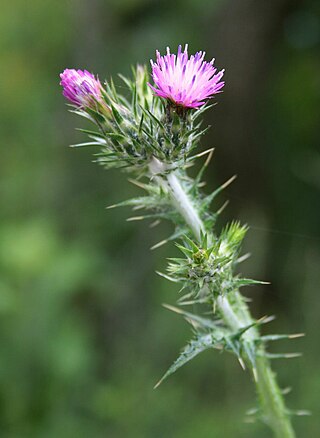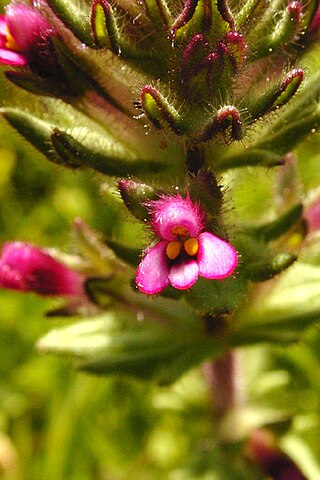
Lonicera etrusca is a species of honeysuckle known by the common name Etruscan honeysuckle. It is native to Southern Europe, Western Asia and North Africa and it is known elsewhere, including the Pacific Northwest of North America, as an introduced species where it has escaped cultivation. It is kept in gardens as an ornamental plant.

Rhinanthus minor, known as yellow rattle, is a herbaceous wildflower in the genus Rhinanthus in the family Orobanchaceae. It has circumpolar distribution in Europe, Russia, western Asia, and northern North America. An annual plant, yellow rattle grows up to 10–50 centimetres (3.9–19.7 in) tall, with upright stems and opposite, simple leaves. The fruit is a dry capsule, with loose, rattling seeds.

Asphodelus fistulosus is a species of plant known as hollow-stemmed asphodel, onionweed, onion-leafed asphodel, and pink asphodel. It is native to the Mediterranean region. It is an invasive exotic weed in the United States, with significant infestations in California, Arizona, New Mexico, and Texas. It is listed as a Federal Noxious Weed by the United States Department of Agriculture. It is also a common weed in parts of Australia, New Zealand, and Mexico, and it thrives in any area with a Mediterranean climate.

Sida rhombifolia, commonly known as arrowleaf sida, is a perennial or sometimes annual plant in the Family Malvaceae, native to the Old World tropics and subtropics. Other common names include rhombus-leaved sida, Paddy's lucerne, jelly leaf, and also somewhat confusingly as Cuban jute, Queensland-hemp, and Indian hemp. Synonyms include Malva rhombifolia. It is used in Ayurvedic medicine, where it is known as kurumthotti.

A parasitic plant is a plant that derives some or all of its nutritional requirements from another living plant. They make up about 1% of angiosperms and are found in almost every biome. All parasitic plants develop a specialized organ called the haustorium, which penetrates the host plant, connecting them to the host vasculature – either the xylem, phloem, or both. For example, plants like Striga or Rhinanthus connect only to the xylem, via xylem bridges (xylem-feeding). Alternately, plants like Cuscuta and some members of Orobanche connect to both the xylem and phloem of the host. This provides them with the ability to extract resources from the host. These resources can include water, nitrogen, carbon and/or sugars. Parasitic plants are classified depending on the location where the parasitic plant latches onto the host, the amount of nutrients it requires, and their photosynthetic capability. Some parasitic plants can locate their host plants by detecting volatile chemicals in the air or soil given off by host shoots or roots, respectively. About 4,500 species of parasitic plants in approximately 20 families of flowering plants are known.

Carduus pycnocephalus, with common names including Italian thistle, Italian plumeless thistle, and Plymouth thistle, is a species of thistle. It is native to the Mediterranean region in southern Europe, North Africa, and Western Asia; Eastern Europe and the Caucasus; and the Indian Subcontinent.

Calycadenia multiglandulosa is a species of flowering plant in the family Asteraceae, known by the common names sticky calycadenia and sticky western rosinweed. It is endemic to California, where it is a common in the Coast Ranges and in the Sierra Nevada Foothills from Shasta County to Kern County.

Orobanche fasciculata is a species of broomrape known by the common name clustered broomrape. It is native to much of western and central North America from Alaska to northern Mexico to the Great Lakes region, where it grows in many types of habitat. It is a parasite growing attached to the roots of other plants, usually members of the Asteraceae such as Artemisia; and other genera such as Eriodictyon and Eriogonum. This plant produces one or more stems from a bulbous root, growing erect to a maximum of about 20 centimeters in height. The stems, leaves and five-lobed flowers are covered by sticky hairs. As a parasite taking its nutrients from a host plant, it lacks chlorophyll as well as a water-storage system. It is variable in color, often yellowish or purple. The inflorescence is a raceme of up to 20 flowers, each on a pedicel up to 15 centimetres long. Each flower has a calyx of hairy triangular sepals and a tubular corolla 1.5–3 cm long. The flower is yellowish or purplish in color.

Orobanche ramosa is a species of broomrape known by the common names hemp broomrape and branched broomrape. It is native to Eurasia and North Africa, but it is known in many other places as an introduced species and sometimes a noxious weed.

Parentucellia latifolia is a species of flowering plant in the family Orobanchaceae known by several common names, including red bartsia, red tarweed, and broadleaf glandweed. It is native to Europe, but it can be found on other continents, including Australia, as an introduced species. This is an erect annual herb producing a stiff, slender stem coated in hairs and sticky glands. It reaches a maximum height near 30 centimeters. The hairy leaves are divided into triangular or lance-shaped lobes. The inflorescence is a raceme of flowers at the end of the stem. The flower is tubular, the calyx of sepals extending about halfway along the centimeter-long corolla. The corolla is magenta in color, sometimes with white areas, and bearing two raised yellow appendages in the lobed throat.

Petrorhagia dubia is a species of flowering plant in the family Caryophyllaceae known by the common name hairy pink. It is native to southern Europe and the Mediterranean Basin, but it is known on other continents, including Australia and North and South America, as an introduced species and sometimes a weed. It is an annual herb growing 25 to 60 centimeters tall, but known to reach 90 centimeters in height. The leaves are up to 6 centimeters long, sheathing the stem at the bases. The inflorescence bears a head-like cluster of flowers, their bases enclosed in a large, expanded mass of wide, claw-tipped bracts. The flower corollas are each further encased in a tubular calyx of sepals. The petals are bright pink to magenta or lavender in color with darker veins. Each is heart-shaped or divided into two lobes at the tip. The fruit is a capsule containing many tiny seeds.

Physalis viscosa is a species of flowering plant in the nightshade family known by many common names, including starhair groundcherry, stellate ground-cherry and grape groundcherry in English, and arrebenta-cavalo, balãozinho, and camambú in Portuguese and Spanish. It is native to South America, and it is known on other continents as an introduced species and sometimes a weed. It can grow in many types of habitat, including disturbed areas.
Solanum triflorum is a species of nightshade, in the family Solanaceae, also known as cutleaf nightshade and small nightshade. Like many nightshades, S. triflorum is native to South America, specifically to Argentina; it has made its way onto other continents, including Europe and Australia, as an introduced species, where it is deemed a weed, at times. It is also typically considered native to much of the Eastern and Western parts of the United states and parts of Canada, although there is some debate on the matter. It grows in many types of habitats, preferring tilled, disturbed terrain for germinating. It is an annual herb, producing sprawling, decumbent stems dotted with new growth. These decumbent, horizontal stems may quickly grow up to a meter in all directions. Solanum triflorum is covered in trichomes and hairs, which are sometimes mistaken for glands. The leaves are a few centimeters long, and deeply “cut” into slightly pointed, serrated lobes, garnering its common name, “cutleaf”. The inflorescence bears two or three flowers, each just under a centimeter wide when fully open. The flower is usually white, but may be greenish or purple-tinged. The fruit is a berry, similar to the nightshade family, roughly a centimeter wide.

Dittrichia viscosa, also known as false yellowhead, woody fleabane, sticky fleabane and yellow fleabane, is a flowering plant in the daisy family.

Trifolium angustifolium is a species of clover known by the common names narrowleaf crimson clover, narrow clover and narrow-leaved clover.

Triphysaria pusilla is a species of flowering plant in the family Orobanchaceae known by the common name dwarf owl's-clover.

Veronica anagallis-aquatica is a species of flowering plant in the family Plantaginaceae known by the common names water speedwell, blue water-speedwell,brook pimpernel.

Vicia pannonica is a species of vetch known by the common name Hungarian vetch. It is native to southern, central Europe and western Asia, and it is sometimes cultivated as an agricultural crop for use as hay and fodder. It may escape cultivation and grow as a casual roadside weed.

Dolichandra unguis-cati, commonly known as cat's claw creeper, funnel creeper, or cat's claw trumpet, is a rapidly growing climbing vine belonging to the family Bignoniaceae. It affects all plant layers of the forest ecosystem spreading rapidly both vertically and horizontally.

Aeschynomene indica is a species of flowering plant in the legume family. Common names include Indian jointvetch, kat sola, budda pea, curly indigo, hard sola, northern jointvetch, indische Schampflanze (German), angiquinho, maricazinho, papquinha, pinheirinho, he meng (Chinese), kusanemu (Japanese), diya siyambala (Sinhala), and ikin sihk (Pohnpeian).



















